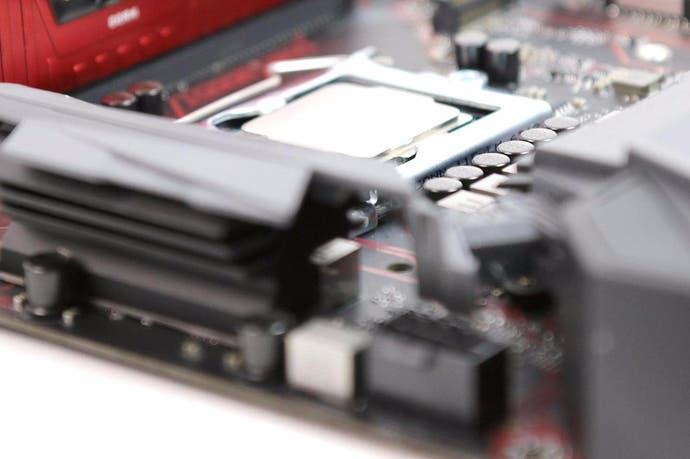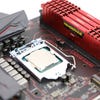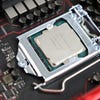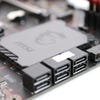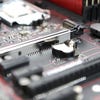Intel Kaby Lake: Core i3 7350K review
Is an overclockable dual-core CPU faster for games than an i5 quad?
We've been waiting for one of these for a long time. We know that Intel's Core i3 technology is good for gaming - up until recently, the Haswell-based Core i3 4130 has been at the heart of our budget PC build - but what if we could overclock it? Could a dual-core i3 operating within striking distance of 5.0GHz work as good, or indeed better, than a locked Core i5 quad-core processor? With the release of the Core i3 7350K, we can finally find out.
On the face of it, the i3 7350K follows Intel's established precedent for its unlocked K chips. The firm takes the top-of-the-line product in the range, bumps up frequency a little and unlocks both base clock and multiplier for overclocking. In the case of the i3 7350K, this is both a good thing and a bad thing. On the one hand, you get the fastest i3 ever made out of the box - it runs at 4.2GHz locked, and you also get the benefit of 4MB of onboard cache (the cheaper i3s and Pentiums have only 3MB). But the bad news is that the 7350K is relatively expensive for what it offers. It's a dual-core chip that cost around £170-£180. That's perhaps too close to the lower-end locked i5 quad core chips out there.
In effect, Intel is asking us to make the comparison: which is better, a stupidly fast dual-core chip, or a more modestly clocked quad? Muddying the waters somewhat is that the lower-end i3s tend to be more reasonably priced - a good £60 to £70 less for an i3 6100 or i3 7100. And then there's the elephant in the room: the Pentium G4560. Intel's Kaby Lake offerings may have underwhelmed in terms of value at the top-end, but there's a quiet revolution occurring in the budget sector. The G4560 shaves off clock-speed and some features, but it's essentially a 3.5GHz version of the i3 - and we picked one up for just £63.
The value proposition is going to cause problems for the i3 7350K. To overclock it at all, you'll need a premium-priced Z170 or Z270-based motherboard. And as we've demonstrated on multiple occasions across all of our processor reviews, CPU-bound gaming scenarios see big performance leaps when the chip is paired with faster memory. Factor in all of this expense and you can't help but wonder whether you shouldn't just increase your budget by £50-£60 and buy the excellent Core i5 7600K instead.
- Buy the Intel Core i3 7350K from Amazon with free shipping.
First up, let's talk test methodology. We retained the Corsair Dominator 3000MHz DDR4 modules used in our prior Kaby Lake reviews, and paired the Core i3 7350K with an MSI Z270 Gaming M3, the aim here being to match the processor with an entry level overclocking board. As it happens, the M3 is extremely close to the excellent M5 we used with the Core i7 7700K - a few top-end features and storage options are removed but the BIOS is effectively the same, and overclocking capabilities are identical. And in this respect, the 7350K possessed the same top-level as the other K chips we received - 5.0GHz is possible but once you push beyond 4.8GHz, the heat becomes a real problem. We opted to remain at 4.8GHz for our overclocking tests for this reason. Even though our cooling set-up - a Corsair H100i GTX - is a top-tier thermal solution, temperatures hit 90 degrees Celsius at 4.9GHz.
A look at basic benchmarks (below) highlights the strengths and weaknesses of the Core i3 7350K. In single-thread tasks, it's an absolute monster - as fast as the Core i7 7700K out of the box. However, its performance in multi-threaded tasks shows a performance deficit against the locked Core i5 6500 we had on hand (even when overclocked) while it's simply not at the races compared to the i5 7600K and of course the top-tier i7 7700K. It's also interesting to note that the Pentium G4560 hands in fairly reasonable results. Of course, it's the slowest processor in the line-up by quite a long chalk but the fact is that the Core i3 7350K is over £110 more expensive. The HEVC media encoding results impact the Pentium significantly - perhaps because AVX2 instruction support is completely removed from the budget offering. For reference, a Core i3 6100 with just a 200MHz speed bump offers a 40 per cent speed increase in HEVC encoding.
However, as we know from prior CPU reviews, benchmarks and media encoding tests (we use Handbrake to re-encode a 4K Rise of the Tomb Raider clip available here) don't reflect gaming results. For that, we run a series of games with our test set-up paired with a Titan X Pascal overclocked, and running at 1080p. This methodology ensures that the CPU is processing the most complex scenes possible within each game engine, while at the same time mostly removing the GPU as the primary limiting factor. It brutally exposes both CPU power and system memory bandwidth.
| Core i3 7350K Stock | Core i5 7600K Stock | Core i7 7700K Stock | Core i3 7350K 4.8GHz | Core i5 7600K 4.8GHz | Core i7 7700K 4.8GHz | Core i5 6500 | Pentium G4560 | |
|---|---|---|---|---|---|---|---|---|
| XTU Benchmark | 760 | 1244 | 1490 | 859 | 1394 | 1552 | 1055 | 336 |
| Cinebench R15 Single-Core | 184 | 173 | 187 | 198 | 203 | 207 | 144 | 145 |
| Cinebench R15 Multi-Core | 450 | 654 | 963 | 503 | 774 | 1050 | 537 | 365 |
| Handbrake 0.10.5 x264 | 6.37fps | 9.6fps | 13.10fps | 7.28fps | 11.50fps | 14.8fps | 8.12fps | 5.11fps |
| Handbrake 0.10.5 x265/HEVC | 2.82fps | 4.84fps | 6.20fps | 3.52fps | 5.80fps | 6.90fps | 4.06fps | 1.92fps |
In our first spread of gaming benchmarks, we wanted to put the Core i3 7350K into context with the i5 and i7 K chips Intel has unleashed in its new Kaby Lake refresh. The 7600K and 7700K represent the most expensive quad-core chips in their respective market sectors, but there is the sense that the i3 7350K may be over-priced for what it offers. There's a £50-£60 price differential between i3 and i5 K chips, and the feeling we had going into testing was that a true quad-core processor would offer a significant performance lead.
The Division and Assassin's Creed Unity benchmarks are still somewhat dominated by GPU restrictions - even with the insane level of graphics power we are throwing at these titles in our tests - and this explains relatively close groupings across all results on these titles. Elsewhere, we're looking at clear steps between the performance of each processor and generally speaking, an overclocked i3 running at 4.8GHz can't match stock performance of the Core i5 7600K. However, two results stand out here: first of all, Far Cry Primal sees some excellent results from the i3 - a product of its engine design which sees one single core power much of the engine, hiving off tasks to other threads. Also intriguing is the Witcher 3 result. The stock i5 is faster of course, but the result is very close for an engine that thrives on as many threads as you can throw at it.
While all of the results can look pretty close, these are average frame-rates. Lowest recorded frame-rates are where you really notice the differential in CPU performance. The Core i3 7350K is a very fast processor, but even with an overclock in place it cannot maintain 60fps in Crysis 3's jungle stage and it barely manages to sustain 60fps in Rise of the Tomb Raider's Geothermal Valley, even at 4.8GHz. For the record, even the i5 at 4.8GHz has issues with Crysis 3 - though it proves perfectly capable in the Tomb Raider stress test. So with all of this data in mind, what happens when we stack up the i3 K chip against less challenging competition more in its price range?
| 1080p/Titan X Pascal OC | Core i3 7350K Stock | Core i5 7600K Stock | Core i7 7700K Stock | Core i3 7350K 4.8GHz | Core i5 7600K 4.8GHz | Core i7 7700K 4.8GHz |
|---|---|---|---|---|---|---|
| Assassin's Creed Unity, Ultra High, FXAA | 104.9 | 121.4 | 132.2 | 110.0 | 125.4 | 132.9 |
| Ashes of the Singularity, DX12, CPU Test | 22.9 | 29.6 | 41.9 | 25.6 | 33.1 | 44.1 |
| Crysis 3, Very High, SMAA T2x | 80.5 | 99.4 | 138.2 | 89.6 | 108.6 | 145.5 |
| The Division, Ultra, SMAA | 124.4 | 132.0 | 133.8 | 129.8 | 134.6 | 133.9 |
| Far Cry Primal, Ultra, SMAA | 104.4 | 117.2 | 137.9 | 115.2 | 137.4 | 140.1 |
| Rise of the Tomb Raider DX12, Very High, SMAA | 68.2 | 89.7 | 126.5 | 75.2 | 97.8 | 131.0 |
| The Witcher 3, Ultra, No Hairworks | 84.1 | 97.7 | 139.4 | 92.1 | 114.9 | 145.2 |
In our second collection of gaming benchmarks, we retain the i3 7350K results, along with the Core i5 7600K stock results (these essentially offer us top-tier, non-overclocked i5 metrics). We don't have the 3.0GHz Core i5 7400 to hand, but we do have the slightly faster Core i5 6500, built on the very similar Skylake architecture, and with the same 3.6GHz boost clock. The Core i3 is generally considered a budget option, so we've also stacked it up against a processor many consider to be the new budget king - the Pentium G4560. Like the i3, it has two cores and four threads, but its clock speeds are limited to 3.5GHz - but that's fine as it costs just 36 per cent of the retail price of the i3 7350K. We picked one up for £63, and it's pretty amazing for its price.
The single-thread king - Far Cry Primal - sees some excellent results for the i3. Whether in stock configuration or with the overclock in place, it handily beats the Core i5 6500. And across the board, some of the results at 4.8GHz see the i3 get very, very close to the locked Skylake i5. Ashes of the Singularity and Crysis 3 even record wins against the locked quad-core processor. However, Far Cry aside, there is no 'killer blow' for the i3 7350K. Essentially, we've pushed a dual-core, quad-thread chip to its limits, throwing power efficiency out of the window and requiring a solid thermal solution to provide mixed results against the i5 6500. Meanwhile, the Skylake quad quietly goes about its business, handing in solid performance and requiring no specialised cooling apparatus - the minuscule heatsink and fan you get out of the box will do the job perfectly fine. And if you have the right Z170 motherboard and load up an older BIOS, the i5 6500 can be overclocked too.
And that's the real issue with the Core i3 7350K. It's about the same price as a locked i5, but to get the most out of it, you'll need an overclocking motherboard and a meaty cooler. Last year, what excited gamers about the Core i3 6100 was the fact that a locked, cheap dual-core chip could be overclocked to 4.5GHz and beyond: a sub-£100 chip could provide some great overclocking returns. By opting to unlock its top-tier i3 instead, the £170-£180 price-point doesn't really offer the same value. Meanwhile, the Pentium G4560 might be the weakest seventh-gen Intel Core processor we've tested, but it's offering 70 to 80 per cent of the i3's performance for just over a third of the price. Kaby Lake does indeed revolutionise the dual-core processor line, but it's the addition of hyper-threading to select Pentiums that proves to be the game-changer.
| 1080p/Titan X Pascal OC | Core i3 7350K Stock | Core i3 7350K 4.8GHz | Core i5 7600K Stock | Core i5 6500 | Pentium G4560 |
|---|---|---|---|---|---|
| Assassin's Creed Unity, Ultra High, FXAA | 104.9 | 110.0 | 121.4 | 113.2 | 87.6 |
| Ashes of the Singularity, DX12, CPU Test | 22.9 | 25.6 | 29.6 | 24.8 | 18.2 |
| Crysis 3, Very High, SMAA T2x | 80.5 | 89.6 | 99.4 | 86.2 | 66.9 |
| The Division, Ultra, SMAA | 124.4 | 129.8 | 132.0 | 131.6 | 114.0 |
| Far Cry Primal, Ultra, SMAA | 104.4 | 115.2 | 117.2 | 97.7 | 87.3 |
| Rise of the Tomb Raider DX12, Very High, SMAA | 68.2 | 75.2 | 89.7 | 77.3 | 55.4 |
| The Witcher 3, Ultra, No Hairworks | 84.1 | 92.1 | 97.7 | 92.3 | 68.6 |
Intel Kaby Lake: Core i3 7350K - the Digital Foundry verdict
The Core i3 7350K is a fascinating experiment. By and large, it validates the notion that the i3 (and by extension) hyper-threading punches above its weight, more so in gaming applications than basic benchmarks and multimedia applications. But the bottom line is that the days of games being driven mostly by single-thread performance are now a thing of the past. Multi-core aware game engines are now the norm and the end result is that in most scenarios, a locked Core i5 processor barely breaking a sweat can offer much the same experience as an i3 pushed to its limits.
We achieved a solid 4.8GHz overclock with the i3 7350K, and while 4.9GHz is also viable on our sample, the heat generated is pretty intense - even when paired with an expensive Corsair H100i GTX closed-loop water cooler. Higher overclocks may be possible depending on the silicon lottery, but a game-changing experience from an extra 200-300MHz is unlikely. Put simply, there are only limited returns in terms of performance. Similar to every Intel CPU we've tested, performance also scales in line with memory bandwidth - as this table demonstrates - so to get the most out of the processor, regardless of how far you overclock it (or not), there's extra frame-rate there for the taking by pairing the CPU with faster memory.
While the Core i3 7350K is a great toy to play with, it's challenging to find the value here. What we want from an overclockable i3 is a genuine value proposition for a budget build - but the fact is that a pricey Z170/Z270 board is required, along with fast memory to get the most from the overclock, plus a decent cooler. Rather than spend the extra money on a heavy duty thermal solution, you can actually save some cash by opting for a Core i5 7500 - which won't require any additional expense on a heatsink and fan and should outperform the Core i5 6500 we used for our locked quad comparisons in this article.
But the genuine surprise from our testing is just how impressive the Pentium G4560 performs bearing in mind its tiny price-point. Historically, Intel's Pentiums and Celerons have been limited to just two threads, leading to major in-game stutter on modern game engines - the main reason it's hard to recommend the overclockable Pentium G3258. This is not an issue with the hyper-threading enabled G4560 - initial results look highly promising and we'll be stacking it up against the other budget processor options in a full review soon.
